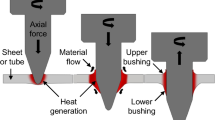Abstract
It is postulated that the main mechanism of the enhancement of material removal rate (MRR) in percussive drilling is associated with generating impact forces, which act on the workpiece and help to develop micro-cracking in the cutting zone. The inherent non-linearity of the discontinuous impact process is modelled as a frictional pair, to generate the pattern of the impact forces. A novel formula for calculating the MRR is proposed, which explains the experimentally observed fall in MRR at higher static forces.
Similar content being viewed by others
References
Grabec, I., 'Chaos generated by a cutting process', Phys. Lett. A, 117 (1986) 384.
Wiercigroch, M., 'Chaotic vibrations of a simple model of the machine tool-cutting process system', ASME, J. Vibr. Acoust. 119 (1997) 468.
Markov, A.I. and Ustinov, I.D., 'A study of the ultrasonic diamond drilling of non-metallic materials', Ind. Diamond. Rev. March (1972) 97.
Markov, A.I., Ultrasonic drilling and boring of hard non-metallic materials with diamond tools, Stanki i Instrument 48 (1977) 33 (in Russian).
Markov, A.I., Ultrasonic machining of materials, Mashinostroenie, Moscow, 1980 (in Russian).
Petrukha, P.G., Ultrasonic diamond drilling of deep holes in brittle materials, Russian. Engng J. L (1980) 71.
Kubota, M., Tamura, J. and Shimamura, N., Ultrasonic machining with diamond impregnated tools, Precision Engng. 11 (1977) 127.
Komaraiah, M., Mannan, M.P., Reddy-Narasimha, P.N. and Victor, S., 'Investigation of surface roughness and accuracy of ultrasonic machining', Precision Engng 10 (1988) 58.
Saha, J., Bhattacharyya, A. and Mishra, P.K., Estimation of material removal rate in USM process: A theoretical and experimental study, In: Proc 27th MATADOR Conference, UMIST, Manchester, April 1988, pp. 275.
Thompson J.M.T. and Ghaffari, R., 'Chaos after period-doubling bifurcations in the resonance of an impact oscillator', Phys. Lett. 91A (1982) 5.
Shaw, S.W., 'Forced vibrations of a beam with one-sided amplitude constraint: Theory and experiment', J. Sound Vibr. 99 (1985) 199.
Wiercigroch, M. and Sin, V.T.W., 'Experimental study of based excited symmetrically piecewise linear oscillator', J. Appl. Mech. 65 (1998) 657–663.
Wiercigroch, M., Neilson, R.D., Player, M.A. and Barber, H., 'Experimental study of rotary ultrasonic machining: Dynamic aspects', Machine Vibr. 2 (1993) 187–197.
Neilson, R.D., Player, M.A. and Wiercigroch, M., 'A dynamic model of ultrasonic drilling', Machine Vibr 2 (1993) 136–143.
Author information
Authors and Affiliations
Rights and permissions
About this article
Cite this article
Krivtsov, A.M., Wiercigroch, M. Dry Friction Model of Percussive Drilling. Meccanica 34, 425–434 (1999). https://doi.org/10.1023/A:1004703819275
Issue Date:
DOI: https://doi.org/10.1023/A:1004703819275




